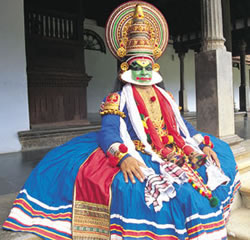 It originated in the indian state of Kerala during the 7th century C.E. The Raja of Kottarakara is the earliest exponent of this art. It is considered to be one of the oldest dance forms in India. It is a spectacular combination of drama, dance, music and ritual. Characters with vividly painted faces and elaborate costumes re-enact stories from the Hindu epics, Mahabharatha and Ramayana.
It originated in the indian state of Kerala during the 7th century C.E. The Raja of Kottarakara is the earliest exponent of this art. It is considered to be one of the oldest dance forms in India. It is a spectacular combination of drama, dance, music and ritual. Characters with vividly painted faces and elaborate costumes re-enact stories from the Hindu epics, Mahabharatha and Ramayana.
Kathakali literally means "story play," and is unique in its avant-garde approach toIndian sacred dance form. The performances are based on incidents contained in sacred Sanskrit classics like Mahabharata![]() and Ramayana,
and Ramayana,![]() on Kerala's own ancient Sanskrit drama Kudiyattam, and on pastimes from Sri Krishna's life that were popularized in Kerala around 1650 A.D.
on Kerala's own ancient Sanskrit drama Kudiyattam, and on pastimes from Sri Krishna's life that were popularized in Kerala around 1650 A.D.
Sacred Indian dance is divided into two categories-vigorous or masculine, and gentle or feminine. Kathakali is most vigorous and is performed by men, yet a similar, gentler form also exists called Kummi in which the performers are mostly women.
Kathakali is considered to be a combination of five forms of fine art: